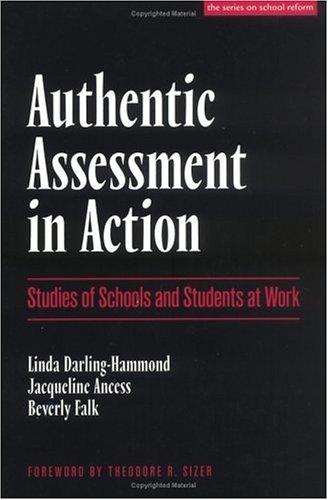

According to Wiggins (1989), authentic assessments have four common characteristics. First, they are designed to be truly representative of performance in the field. Students actually do writing—for real audiences—rather than taking spelling tests or answering questions about writing. They conduct science experiments, rather than memorizing disconnected facts about science. The tasks are contextualized, complex intellectual challenges involving the student’s own research or use of knowledge in “ill-structured” tasks requiring the development and use of meta-cognitive skills. They also allow appropriate room for student learning styles, aptitudes, and interests to serve as a source for developing competence and for the identification of (perhaps previously hidden) strengths.
Second, the criteria used in the assessment seek to evaluate “essentials” of performance against well-articulated performance standards. These are openly expressed to students and others in the learning community, rather than kept secret in the tradition of fact-based examinations that are kept i “secure.” Knowing the tasks and the standards is not “cheating” when a task requires an actual performance, rather than the recognition of a single right answer from a list, and when the task is intrinsically valuable and inherently complex. Learning and performance are both supported when teachers and students know ahead of time that an assessment will focus, for example, on students’ demonstrated ability to evaluate competing viewpoints and use evidence in developing a persuasive essay concerning a topic of social importance.
The criteria suggested by such a task represent a performance standard because they are based on explicit and shared school-wide aims, and they are multifaceted, representing the various aspects of a task, rather than reduced to a single dimension or grade. Because the criteria are performance oriented, they guide teaching, learning, and evaluation in a way that illuminates the goals and processes of learning, placing teachers in the role of coach and students in the role of performers, as well as of self-evaluators.
As suggested above, self-assessment plays an important role in authentic tasks. A major goal of authentic assessment is to help students develop the capacity to evaluate their own work against public standards, to revise, modify, and redirect their energies, taking initiative to assess their own progress. This is a major aspect of self-directed work and of the self-motivated improvement required of all human beings in real world situations. Because performance standards take the concept of progress seriously— making the processes of refinement and improvement of products a central aspect of the task and its evaluation—they also allow students of all initial levels of developed competence the opportunity to see, acknowledge, and receive credit for their own growth.
Finally, the students are often expected to present their work publicly and orally. This deepens their learning by requiring that they reflect on what they know and frame it in a way that others can also understand. It also ensures that their apparent mastery of an idea, concept, or topic is genuine. This characteristic of authentic assessment serves other goals as well—signaling to students that their work is important enough to be a source of public attention and celebration; providing opportunities for others in the learning community—students, faculty, and parents—to continually examine, refine, learn from, and appreciate shared goals and achievements; and creating living representations of the purposes and standards of the learning community, so that they remain vital and energizing.
Darling-Hammond, Linda, Ancess, Jacqueline, and Falk, Beverly. 1995. Authentic Assessment in Action: Studies of Schools and Students at Work. New York: Teachers College Press. pp. 11-2. || Amazon || WorldCat